Seasonal Considerations
The Sonoran Desert is a place of extremes, very hot in the summer and cold in the winter. Day and night temperature fluctuations of 40 degrees or more are not uncommon. Spring and fall offer the mildest weather conditions.
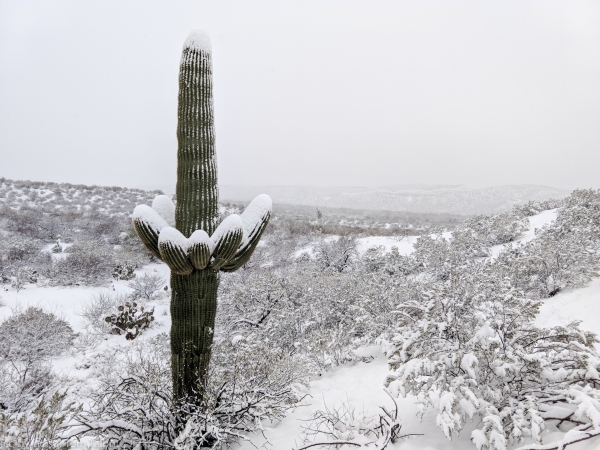
Winter (December – February):
Daytime temperatures are typically in the 50’s and 60’s, with nights below freezing, often in the low 20’s. Snow is rare but possible. Deciduous trees like cottonwood and mesquite lose their leaves. The variability of winter means that good sleeping bags and warm clothing are essential. Dressing in layers is recommended. Sun can still be intense, making broad-brimmed hats, skin protection, and sunglasses necessary.
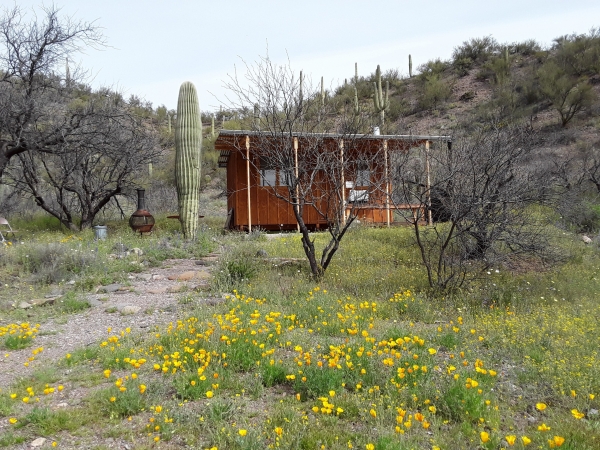
Spring (March – April):
Daytime temperatures typically range from the 60’s to the 90’s, with a lot of variability and strong winds. Nighttime temperatures can still dip below freezing. Wildflowers and small shrubs are in bloom. This is an excellent time for sojourning.
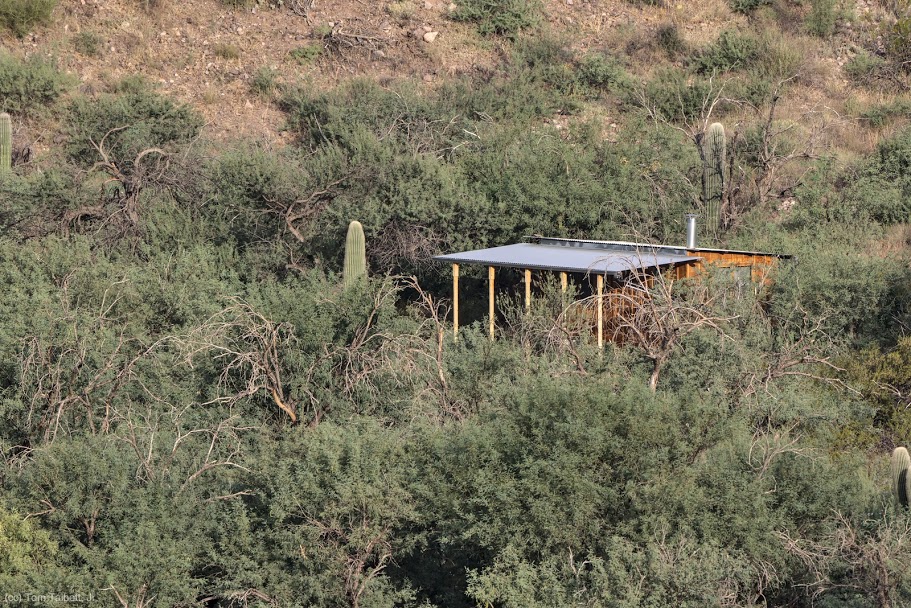
Early Summer (May – June):
Daytime temperatures are commonly near 100 degrees or higher, and nighttime lows can be as much as 50 degrees cooler. Winds moderate, and light breezes or calm periods are more prevalent. Larger plants such as saguaro, yuccas, palo verde, acacia, creosote, and mesquite are in bloom. Lizards, snakes, spiders, and insects become fully active. Morning and evening coolness is pleasant, but generally this is a season for the hardier visitor.
In early and late summer it is essential to drink a lot of water (a gallon a day or more) and supplement with salt. We recommend wearing lightweight pants and long-sleeved shirts, rather than shorts and tank tops, as they offer better protection from sun and insects. Broad-brimmed hats, sunscreen, and sunglasses are recommended.
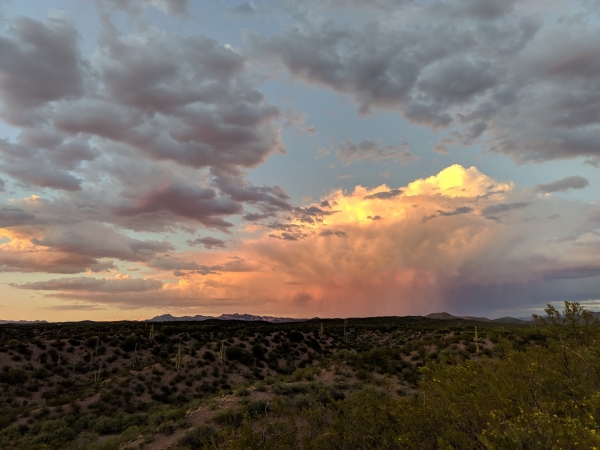
Late Summer (July – September):
This is our most dramatic season with wild storms and breathtaking sunsets. It can also be one of the most challenging seasons with gnats, mosquitoes, humidity, and high nighttime temperatures. Daytime temperatures moderate slightly as the “monsoons” bring moist air and thunderstorms, but the added humidity causes the nights to stay warmer. Severe thunderstorms can cause flash flooding in washes, and lightning is a threat.
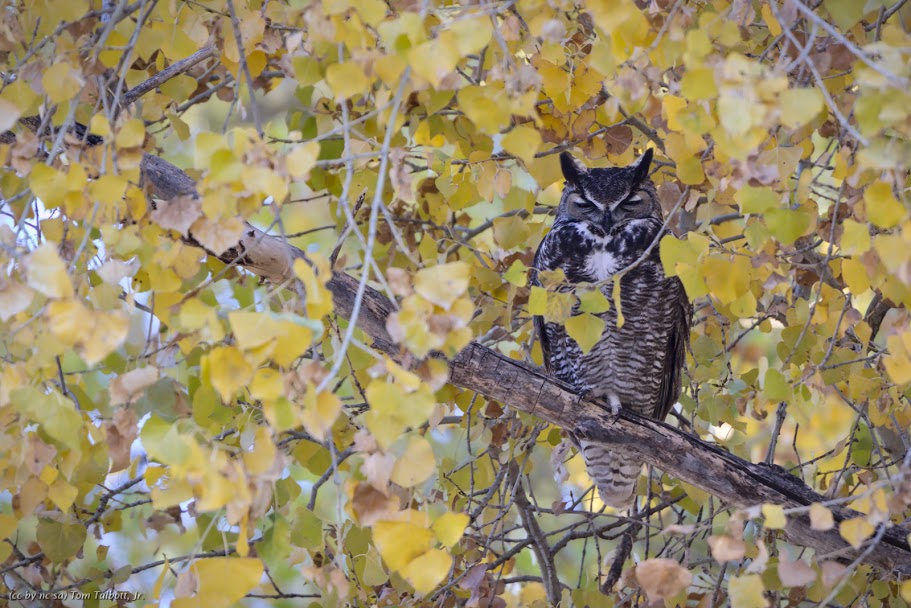
Fall (October – November):
Daytime temperatures begin to moderate, typically ranging from the 70’s to the 90’s. Nights can be quite chilly or even freezing. The broadleaf trees up the canyon or on the river change colors. Insects are still prevalent but not so severe. Fall, like spring, is one of the most delightful times for sojourning. Temperatures are mild, leaves are still on the trees, and there is still plenty of daylight.
Health and Safety
Life in the desert can be harsh, especially under primitive conditions. Prospective sojourners must take responsibility for realistically evaluating their physical capabilities. This experience is generally best suited for physically active and healthy individuals.
The physical realities and the psychological stressors that can occur in solitude must be considered. Sojourners must seriously and realistically evaluate their emotional tolerance for being alone in a remote wildland setting. This experience is recommended for emotionally and spiritually mature and stable individuals who have prior experience with solitude.
Although this area is marginally populated, please be aware that you will be alone under relatively primitive conditions during your sojourn. A CCA volunteer checks on sojourners daily by remotely observing a signal system located at each hermitage. Signal checks are made once every 24 hours. We try to make people aware of potential environmental dangers. If hiking away from the hermitage, be careful not to explore beyond your endurance and not to get lost. You must carry sufficient water—two quarts is minimal, a gallon better. Falls and sprained ankles are a primary hazard, so good footwear and watching your step are critical. Terrain can be rocky, steep, and loose. We ask that you leave a note at the hermitage as to your direction, general destination, and departure time.
Emergency Care
In case of emergency, a first-aid kit is on site, but local healthcare resources are limited. A CCA volunteer cannot guarantee provision of emergency care. It is a one-hour drive to the nearest medical care.
Plant and Animal Hazards
A majority of the plants have serious spines or thorns. Wearing a long-sleeved shirt and long pants are recommended.
A book of venomous animals is available for review at each hermitage. Learn to identify dangerous desert dwellers and their habits so you can avoid them. Potentially dangerous desert dwellers include: rattlesnakes, Gila monsters, scorpions, cone-nose beetles, centipedes, black widow spiders, ants, bees, wasps, etc. Generally they are not a concern if common sense is observed, but one would do well to learn about them and take due precautions.
Provisions
Sojourners are expected to provide their own food (including condiments) and equipment as suggested below. There is no refrigeration, so dried or non-perishable food items are best. While you will be driven to the Cottage Hermitage, at the Caravan Hermitage you will be carrying all your supplies, including water, on a 15-minute hike up a sandy wash to the hermitage, so pack accordingly—more like backpacking and less like car camping.
To Bring
sleeping bag or twin-bed sheets or blanket(s) (review “Seasonal Considerations”)
pillow
bath towel
water bottles
flashlight
broad-brimmed hat
sunscreen
sun glasses
insect repellant
suitable clothing (see “Seasonal Considerations”)
trekking poles or walking stick for hiking if needed
toiletries–Only biodegradable products, please. A general-purpose biodegradable soap is provided that can be used for dishes, laundry, and bathing.
Provided
drinking water
2-burner stationary Coleman propane stove and propane
outdoor chimenea, indoor wood stove, and wood (Cottage Hermitage only—no fires are allowed at the Caravan)
sun-oven
solar lantern
hot water kettle
pots/pans
cooking utensils
eating utensils
dishes/cups
dish washing supplies
toilet paper
two hot water bottles (for warmth)
garbage bags
What Not to Bring
Because our intent is to provide a place for true solitude in wildlands, we strongly discourage the use of electronic transmitters and receivers during sojourns, including cell phones, portable radios, TVs, etc. (Cell phone coverage is poor to non-existent.)
We also ask that you not bring candles, incense, or other strongly-scented products.
Getting to the Corbett Center and Caravan Hermitage
Personal vehicles will be left in a designated parking area and a CCA staff member will shuttle the sojourner and their personal belongings to their destination. Sojourners and groups can be driven to the Corbett Center, but it is a 15-minute walk up a sandy wash to get to the Caravan Hermitage. No provision is made for restocking or driving in and out during a retreat.
About | Facilities | Prepare to Sojourn | Sojourn Application | History
Spring: Susan Tollefson / All other photos: Tom Talbott, Jr.
